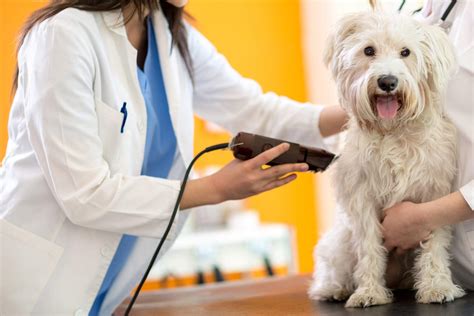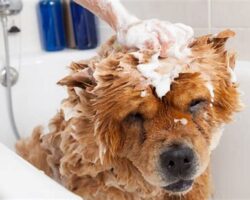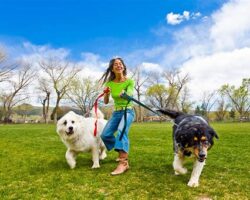Gathering the Essential Grooming Tools
Grooming your dog is an essential part of keeping them healthy and happy. By regularly grooming your furry friend, you can prevent matting, maintain a clean coat, and check for any potential health issues. To get started with grooming, it’s important to gather the essential grooming tools. Having the right tools will not only make the grooming process easier and more efficient but also ensure the safety and comfort of your dog.
When it comes to grooming tools, there are several items that you should have in your toolkit:
- Grooming comb: A grooming comb with both wide and narrow teeth is ideal for combing through your dog’s fur and removing any tangles or mats.
- Brush: A brush is essential for removing loose fur, keeping the coat clean, and preventing matting. Depending on your dog’s coat type, you may need a slicker brush, a bristle brush, or a de-shedding tool.
- Nail clippers or grinder: Keeping your dog’s nails trimmed is important for their comfort and overall health. Invest in a good quality pair of nail clippers or a nail grinder to safely and effectively trim your dog’s nails.
- Ear and eye cleaner: Dogs are prone to ear infections and eye irritations, so having a gentle ear and eye cleaner is essential. Look for products specifically formulated for dogs and avoid using any harsh chemicals.
- Toothbrush and toothpaste: Just like humans, dogs need their teeth brushed regularly to prevent dental issues. Use a soft toothbrush and dog-friendly toothpaste to keep your dog’s teeth clean and their breath fresh.
By having these essential grooming tools at your disposal, you’ll be well-prepared to maintain your dog’s grooming needs. Remember to always use gentle and positive reinforcement during the grooming process to ensure a positive experience for both you and your furry friend.
Preparing Your Dog for the Grooming Session
Grooming your dog is an essential part of maintaining their overall health and well-being. However, many dogs can feel anxious or stressed about the grooming process. To ensure a calm and successful grooming session, it is important to properly prepare your dog beforehand. Here are some tips to help you get your dog ready for their grooming appointment:
1. Familiarize your dog with the grooming environment: Take your dog for a visit to the grooming salon before their scheduled appointment. This will help them become familiar with the sights, sounds, and scents of the grooming area, making them feel more comfortable on the actual day.
2. Socialize your dog: If your dog is not used to being around other people or animals, it is crucial to socialize them before the grooming session. Take them for regular walks, visit parks, and introduce them to new experiences to build their confidence.
3. Practice handling your dog: Get your dog accustomed to being touched and handled in various areas of their body. Gently touch their paws, ears, and tail, rewarding them with treats or praise to create positive associations. Gradually increase the duration and intensity of the handling sessions to prepare them for the grooming process.
4. Maintain a regular grooming routine: Regularly brushing your dog’s fur, cleaning their ears, and brushing their teeth will help them get used to the sensations and procedures involved in grooming. Make it a positive experience by providing treats or using grooming tools that they enjoy.
By following these tips, you can effectively prepare your dog for their grooming session and ensure a stress-free experience for both you and your furry friend. Remember, patience and positive reinforcement are key in making grooming a positive and enjoyable activity for your dog!
Brushing and Detangling Your Dog’s Fur
Brushing and detangling your dog’s fur is an important part of their grooming routine. Not only does it keep their coat looking neat and beautiful, but it also helps to maintain their overall health and comfort. Regular brushing removes dirt, debris, and dead hair from your dog’s fur, preventing mats and tangles from forming. Additionally, it promotes good blood circulation and stimulates the production of natural oils, which keep their skin nourished and their coat shiny.
To effectively brush and detangle your dog’s fur, you will need a few essential grooming tools. These include a slicker brush, a comb with wide and narrow teeth, and possibly a dematting tool for stubborn tangles. It is essential to choose the right type of brush and comb for your dog’s breed and coat type. For example, a slicker brush is perfect for removing loose hair and detangling long-haired and double-coated breeds, while a comb with wide teeth is suitable for larger tangles or mats.
When brushing your dog, start from the top and work your way down, gently brushing in the direction of hair growth. Be sure to pay extra attention to areas prone to matting, such as behind the ears, under the armpits, and around the tail. If you encounter any mats or tangles, use a comb with narrow teeth or a dematting tool to carefully work through the knots. It is essential to be gentle and patient while detangling to avoid causing discomfort or pain to your furry friend.
- Regular brushing and detangling sessions are especially important for long-haired and double-coated breeds. These breeds are more prone to mats and tangles, which can lead to skin irritation and even infections if left unattended.
- Brushing your dog’s fur not only removes loose hair and tangles but also helps spread their natural oils throughout the coat. This keeps their skin moisturized and their fur healthy and shiny.
- Aside from the physical benefits, brushing and detangling your dog’s fur can be a bonding experience for both of you. Take your time and make it an enjoyable moment for your furry friend.
| Grooming tool | Best for |
|---|---|
| Slicker brush | Removing loose hair and detangling long-haired and double-coated breeds |
| Comb with wide teeth | Detangling larger tangles or mats |
| Dematting tool | Working through stubborn tangles or mats |
Remember, regular brushing and detangling sessions are essential for maintaining your dog’s fur health and appearance. They not only keep your furry companion looking their best but also contribute to their overall well-being. So, grab your grooming tools, give your dog some extra love, and enjoy the benefits of a well-groomed and happy pup!
Trimming Your Dog’s Nails Safely
Trimming your dog’s nails is an essential part of their grooming routine. Regular nail trims help prevent discomfort and potential health issues for your furry friend. However, it can be a challenging task to perform, especially if your dog is not accustomed to having their paws handled. In this blog post, we will guide you through the process of trimming your dog’s nails safely and efficiently.
The Importance of Nail Trimming
Keeping your dog’s nails at an appropriate length is crucial for their overall well-being. Overgrown nails can cause various problems, including pain, difficulty walking, and even joint misalignment. Long nails may also get caught in carpets or other surfaces, leading to painful injuries. By regularly trimming your dog’s nails, you can avoid these issues and ensure their paws stay healthy and comfortable.
How to Trim Your Dog’s Nails
When it comes to trimming your dog’s nails, it’s essential to use the right tools and techniques to ensure a safe and stress-free experience for both you and your pet. Here’s a step-by-step guide:
- Gather all the necessary tools: nail clippers, styptic powder, and treats for positive reinforcement.
- Find a quiet and well-lit area where you can comfortably groom your dog.
- Slowly introduce your dog to the nail trimming process by touching and handling their paws gently. Reward them with treats for positive reinforcement.
- Choose a calm moment when your dog is relaxed to begin trimming their nails.
- Hold your dog’s paw firmly but gently and locate the quick, which is the pink area within the nail. Avoid cutting into the quick as it is sensitive and may cause bleeding.
- Using the nail clippers, make a small, cautious cut at a 45-degree angle. Trim just a small portion at a time to avoid any accidents.
- If you accidentally cut into the quick and your dog’s nail bleeds, apply some styptic powder to stop the bleeding.
- Continue trimming the nails, gradually working your way to the desired length.
- Remember to give your dog plenty of praise and rewards throughout the process to keep them calm and cooperative.
Tips for a Successful Nail Trimming Session
Here are some additional tips to make the nail trimming session a positive experience:
- Start nail trimming sessions when your dog is still young to help them get accustomed to the process early on.
- Be patient and take breaks if your dog becomes anxious or stressed.
- Use treats or toys as distractions to keep your dog focused and relaxed during the nail trimming session.
- If you’re unsure about trimming your dog’s nails or if your dog has particularly long or dark nails, consult a professional groomer or veterinarian for guidance.
Conclusion
Regular nail trims are a vital aspect of your dog’s grooming routine. By following the proper techniques and using the right tools, you can trim your dog’s nails safely and ensure their comfort and well-being. Remember to take it slow, be patient, and provide positive reinforcement throughout the process. Happy trimming!
Cleaning Your Dog’s Ears and Eyes
Caring for your dog’s ears and eyes is an important aspect of grooming that can sometimes be overlooked. Regular cleaning and maintenance of these areas can help prevent infections, discomfort, and potential health issues. In this blog post, we will discuss the essential tools and techniques for keeping your dog’s ears and eyes clean and healthy.
When it comes to cleaning your dog’s ears, there are a few key tools that you will need. Firstly, you will need a good quality ear cleaner specifically designed for dogs. Avoid using any products that contain alcohol or hydrogen peroxide, as these can be harsh and irritating to your pet’s ears. Additionally, you will need a soft cloth or cotton balls to gently wipe away any dirt or debris.
Now let’s move on to the actual cleaning process. Begin by inspecting your dog’s ears for any signs of redness, swelling, or discharge. If you notice any of these symptoms, it is best to consult with your veterinarian before attempting to clean the ears. Assuming everything looks healthy, you can start by applying a few drops of the ear cleaner into your dog’s ear canal. Gently massage the base of the ear to distribute the cleaner, and then use the cloth or cotton balls to remove any dirt or excess liquid.
When it comes to cleaning your dog’s eyes, it is essential to be gentle and use caution. Start by using a clean, damp cloth to wipe away any debris or crust that may have accumulated around the eyes. Avoid using any harsh chemicals or soaps near the eyes, as these can cause irritation. If you notice any excessive tearing, redness, or discharge, it is best to consult with your veterinarian, as this could be a sign of an underlying issue.
In summary, regular cleaning and maintenance of your dog’s ears and eyes is crucial for their overall health and well-being. Remember to use appropriate tools and gentle techniques to avoid causing any discomfort or harm to your furry friend. By taking the time to properly clean these areas, you can help reduce the risk of infections and ensure that your dog feels comfortable and happy.
Bathing and Drying Your Dog
Bathing and drying your dog is an essential part of their grooming routine. Regular baths help keep your dog’s coat clean, healthy, and free from dirt and odor. It also helps in maintaining their overall hygiene and prevents skin issues. However, bathing a dog can sometimes be a challenging task, especially if they are reluctant or anxious about water. In this blog post, we will discuss the step-by-step process of bathing and drying your dog, along with some valuable tips to make this experience as stress-free as possible.
Before starting the bathing process, gather all the essential grooming tools you will need. These include a dog-friendly shampoo, a soft-bristle brush, a washcloth, cotton balls, a towel, and a blow dryer (if your dog is comfortable with it). Organizing these tools beforehand will ensure that you have everything at your disposal and make the bathing process smoother.
Now let’s dive into the step-by-step guide for bathing and drying your dog:
- Prepare the bathing area: Find a suitable location where you can bathe your dog comfortably. It can be a bathtub, a sink, or a specially designed dog bathing station. Make sure the area is well-lit and has a non-slip surface to prevent accidents.
- Brush your dog’s coat: Before getting your dog wet, give their coat a thorough brush to remove any tangles or mats. This will make the bathing process easier, and it will also help in preventing the formation of mats when the fur is wet.
- Wet your dog: Use lukewarm water to wet your dog’s entire body. Be mindful of their face and ears, as dogs are often sensitive in these areas. Use a washcloth to gently clean their face, avoiding the eyes and ears.
- Apply shampoo: Dilute the dog-friendly shampoo according to the instructions on the bottle, and then apply it to your dog’s coat. Massage the shampoo gently, ensuring that it reaches all areas of their body. Pay extra attention to areas that tend to get dirtier, such as the paws and underbelly.
- Rinse thoroughly: Thoroughly rinse off the shampoo from your dog’s coat with lukewarm water. Make sure to remove all traces of shampoo, as leftover residue can irritate their skin.
- Dry your dog: Use a towel to gently pat your dog’s coat and remove excess water. If your dog is comfortable with it, you can also use a blow dryer on a low heat and speed setting to dry their fur. Keep the dryer at a safe distance and continuously move it to prevent overheating or discomfort.
Now that you know the step-by-step process of bathing and drying your dog, it’s essential to note that every dog is unique. Some dogs may enjoy bath time, while others may be fearful. Take your dog’s individual preferences and needs into consideration, and always prioritize their safety and comfort during the grooming process.
In summary, bathing and drying your dog is a crucial aspect of their overall grooming routine. By following the steps mentioned above, you can ensure that your dog stays clean, comfortable, and happy. Remember to gather all the necessary grooming tools, take it step by step, and most importantly, show your furry friend lots of love and patience throughout the process.
Finishing Touches: Brushing Teeth and Trimming Paw Pads
When it comes to grooming our furry friends, we often focus on their fur, nails, and ears. However, one important aspect of grooming that should not be overlooked is taking care of their teeth and paw pads. While it may seem like a small detail, brushing your dog’s teeth regularly and keeping their paw pads healthy can make a big difference in their overall well-being. In this blog post, we will discuss the importance of these finishing touches in your dog’s grooming routine.
First and foremost, let’s talk about brushing your dog’s teeth. Just like humans, dogs can also suffer from dental problems such as plaque buildup, gum disease, and bad breath. Regularly brushing your dog’s teeth can help prevent these issues and promote good oral health. You can use a specially formulated dog toothbrush and toothpaste to gently clean your dog’s teeth. It is important to be patient and gradually introduce this routine to your canine companion to avoid any discomfort. Brushing your dog’s teeth a few times a week will keep their pearly whites in top shape.
Now let’s move on to trimming your dog’s paw pads. Paw pads serve as a protective layer for your dog’s feet, and it is crucial to keep them in good condition. Overgrown paw pads can be uncomfortable for your furry friend and may even cause difficulty in walking. Regular paw pad trimming can help prevent any potential issues. To trim the paw pads, you can use a pair of blunt-ended scissors, making sure to only remove the excess hair and not cutting too close to the skin. It is essential to be gentle and cautious to avoid any injuries.
Frequently Asked Questions
Question 1: How often should I groom my dog?
The frequency of grooming depends on the breed and the specific needs of your dog. Generally, dogs with longer coats require more frequent grooming, such as brushing and detangling, at least a few times a week. Dogs with shorter coats may only need to be groomed once a week or even less frequently.
Question 2: How can I safely trim my dog’s nails?
It’s important to use proper techniques and tools when trimming your dog’s nails to avoid injury. Start by using a pet nail clipper or grinder designed specifically for dogs. Take small, gradual cuts, avoiding the quick (the sensitive part of the nail). If you’re unsure or uncomfortable doing it yourself, consult a professional groomer or veterinarian for assistance.
Question 3: How should I clean my dog’s ears and eyes?
For cleaning your dog’s ears, use a veterinarian-recommended ear cleaning solution and gently wipe the outer part of the ear with a clean cloth or cotton ball. Avoid inserting anything deep into the ear canal. For cleaning your dog’s eyes, use a damp, clean cloth to wipe away any discharge or dirt from the corners of the eyes, always being gentle and careful not to touch the eyeball itself.
Question 4: Can I use human shampoo to bathe my dog?
No, it is not recommended to use human shampoo on dogs. Human shampoos can contain ingredients that may be harmful or irritating to a dog’s skin or coat. It’s best to use a gentle, dog-specific shampoo that is pH-balanced for their skin and coat. This will help maintain the natural oils and balance of your dog’s fur.
Question 5: How do I brush my dog’s teeth?
To brush your dog’s teeth, use a dog-specific toothbrush and toothpaste. Gently introduce your dog to the toothbrush and toothpaste, allowing them to smell and taste it. Start by brushing the front teeth and gradually work your way back. Use circular motions and be cautious not to apply too much pressure. Aim for a daily brushing routine, but even brushing a few times a week can make a difference in your dog’s oral hygiene.
Question 6: How do I trim my dog’s paw pads?
Trimming your dog’s paw pads should be done carefully to avoid cutting too much. Use rounded-tip scissors or a clipper specifically designed for paw pad trimming. Gently lift your dog’s paw and trim the hair around the paw pad, keeping it even with the pad itself. Be cautious not to cut into the pad or the webbing between the toes.
Question 7: Can I groom my dog at home or should I take them to a professional?
Grooming your dog at home is possible, but it may be beneficial to seek professional assistance, especially if you are inexperienced or your dog requires advanced grooming techniques. Professional groomers have the knowledge and experience to handle different breeds and coat types, ensuring a safe and effective grooming session. However, with proper education, tools, and practice, many dog owners successfully groom their dogs at home.





